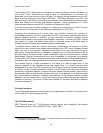
DIGITAL RADIO GUIDE APPENDIX A: EUREKA 147
97
Table A.2: Example of possible number of programs
Protection level (increasing protection)
Audio data
rate (kbps)
54321
24* N/A 64 48 36 24
32 54 41 36 29 24
64 27 20 18 14 12
128 13 10 9 7 6
192 9 7 6 5 4
224 7 6 5 4 3
256 6 5 4 3 3
* At most audio data rates, Eureka 147 uses Unequal Error Protection an error protection
procedure which allows the bit error characteristics to be matched with the bit error sensitivity of
the different parts of the audio frame. At the lowest data rate, 24 kbps, Eureka 147 uses Equal
Error Protection, an error protection procedure which ensures a constant protection of the bit
stream.
Audio Quality
ITU R Recommendation BS.1115 specifies use of MPEG 1 Layer II at 256 kbps (stereo mode),
for broadcast applications requiring CD quality. This recommendation is based on subjective
listening tests undertaken in 1992. At the time, MPEG 1 Layer II at 192 kbps (joint stereo mode)
was also tested but was found to only marginally meet the audio quality requirement. Additional
tests in 1993 failed to reveal sufficient improvement in the codec to warrant inclusion of this lower
data rate in the ITU recommendation.
Further listening tests were performed in 1995, as part of the US Electronic Industries
Association’s (EIA) evaluation of digital radio systems. A range of audio coding systems were
tested including MPEG 1 Layer II at 224 and 192 kbps (joint stereo modes). The findings of this
work indicate the MPEG 1 Layer II codec at 224 kbps is capable of meeting the basic audio
quality criteria specified by the ITU R. The lower rate of 192 kbps again failed to meet the
required quality.
Spectrum Issues
Eureka 147 Channel Plans
In 1995, the introduction of terrestrial Eureka 147 was discussed by the European Conference for
Posts and Telecommunications (CEPT) in Wiesbaden.
17
In cooperation with representatives of
regional and international organisations such as the EBU, the European Commission and the ITU
a total of 73 channels to be used for future and current digital audio broadcasting services was
agreed. Each channel is 1.536 MHz wide with appropriate guard bands between each channel
and at the edge of each band.
17
Final Acts of the CEPT T_DAB Planning Meeting (3)”, Maastricht 2002,CEPT,
http://www.ero.dk/52EB3135-F356-49FF-A970-B32D2C745921?frames=0


















